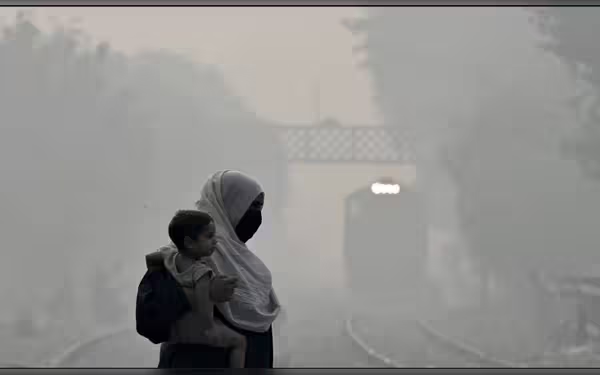Friday, November 8, 2024 03:04 AM
Peshawar's Winter Smog Crisis: Urgent Action Needed
- Peshawar faces severe winter smog health risks.
- Temperature inversion worsens air quality crisis.
- Urgent measures required to combat pollution.
 Image Credits: thefridaytimes
Image Credits: thefridaytimesPeshawar is facing a severe winter smog crisis, posing serious health risks and requiring urgent action to improve air quality.
As winter approaches, Peshawar, a city rich in history and culture, is grappling with a pressing environmental issue: smog. This thick haze, a mix of smoke and fog, is not just an eyesore; it poses serious health risks to the residents. Peshawar has earned the unfortunate title of the second most polluted city in Pakistan, with alarming levels of harmful pollutants like particulate matter (PM2.5), nitrogen oxides, and sulfur dioxide. These pollutants primarily come from vehicles, factories, and the burning of solid fuels, especially in poorer neighborhoods.
During the winter months, a weather phenomenon known as temperature inversion occurs. This means that cooler air gets trapped close to the ground, preventing the harmful pollutants from dispersing. As a result, the air quality worsens, leading to a public health crisis that is not unique to Peshawar but is part of a larger trend seen in many urban areas across Asia. Cities like New Delhi and Lahore also frequently rank among the most polluted in the world.
Rapid urbanization, increased vehicle usage, and reliance on traditional fuels for cooking and heating are significant contributors to this dire situation. Recent studies from organizations like the World Bank and the Food and Agriculture Organization (FAO) highlight the severe health impacts of air pollution, especially in regions with harsh winters. For instance, exposure to high levels of PM2.5 can lead to serious health issues, including higher mortality rates and worsening of heart and lung diseases. In Peshawar, individuals exposed to severe air pollution are at a 20% higher risk of developing chronic respiratory diseases, with children being particularly vulnerable.
Once upon a time, winter in Peshawar was a season filled with the charm of early morning mists and the warm scent of wood burning in hearths. However, those days seem to have faded, replaced by a thick haze that not only obscures the view but also dampens the spirit of the city. Locals have coined the term "sipina tayara" to describe the current smog, referring to it as a "white darkness" that makes it difficult to see even during the day.
The health impacts of this environmental crisis are widespread. Vulnerable groups, including children, the elderly, and those with pre-existing health conditions, face increased risks. Hospitals in Peshawar are witnessing a surge in cases of asthma, bronchitis, and other respiratory issues, stretching healthcare services to their limits. Moreover, the reduced visibility caused by smog has led to more road accidents, highlighting the urgent need for safety measures such as lower speed limits and better driving practices.
Addressing Peshawar's air quality crisis requires more than quick fixes; it calls for long-term strategies and comprehensive policy reforms. Authorities must implement stricter emission standards, promote cleaner transportation options, and improve public transit systems to reduce reliance on private vehicles. Investing in electric transport and real-time air quality monitoring can significantly help in reducing pollution levels. Additionally, creating more green spaces in the city can provide natural filtration for pollutants and enhance the overall quality of life for residents.
On an individual level, families can take steps to protect themselves from smog. Using air purifiers, ensuring proper ventilation indoors, and wearing masks during high pollution periods are practical measures that can help reduce health risks. It is essential for vulnerable individuals to be aware of the early signs of pollution-related health problems and to seek medical help when needed.
In tackling these challenges, a focus on sustainable urban development is crucial. By prioritizing public health and environmental care, Peshawar can work towards a cleaner and healthier future. The once-clear winter skies may seem like a distant memory, but with collective action, there is hope for recovery and sustainable progress.
Furthermore, the international community must recognize the shared responsibility in combating air pollution. Collaborative efforts, such as sharing best practices and implementing effective air quality management strategies, are vital. Countries facing similar challenges can learn from each other, adopting measures like stricter emission controls and public awareness campaigns about the dangers of air pollution.
As we reflect on the air quality challenges faced by Peshawar, it becomes clear that solutions must be multi-faceted. Government policy changes, community engagement, and individual actions are all necessary to combat this pressing issue. With a united effort, we can transform the smog-laden winter skies into a future where clear air and good health are within reach for all.













